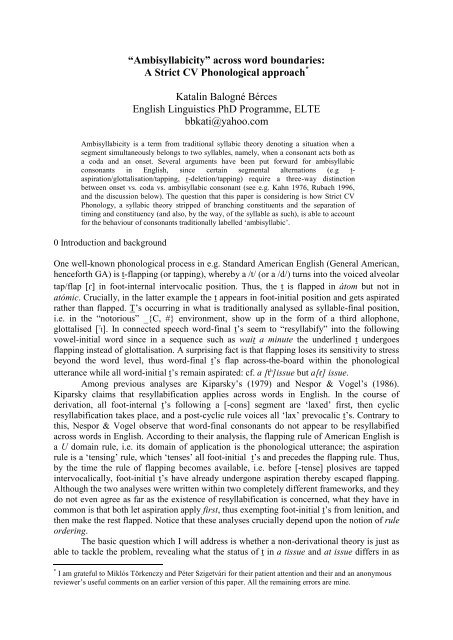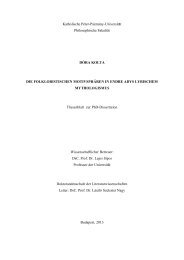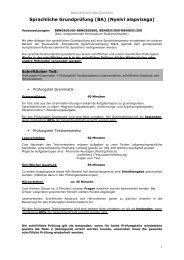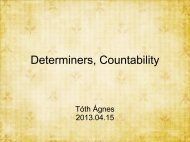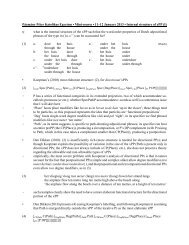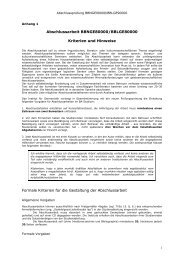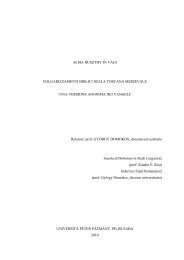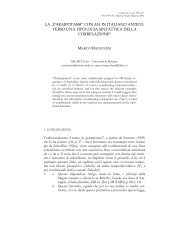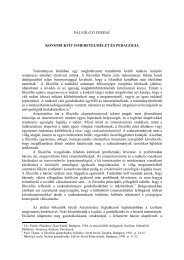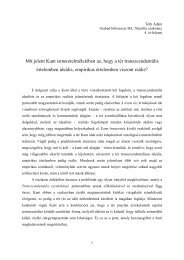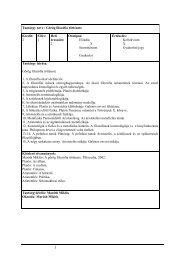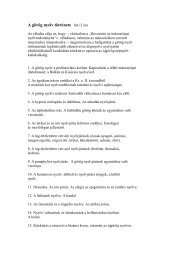“Ambisyllabicity” across word boundaries:
“Ambisyllabicity” across word boundaries:
“Ambisyllabicity” across word boundaries:
You also want an ePaper? Increase the reach of your titles
YUMPU automatically turns print PDFs into web optimized ePapers that Google loves.
<strong>“Ambisyllabicity”</strong> <strong>across</strong> <strong>word</strong> <strong>boundaries</strong>:<br />
A Strict CV Phonological approach *<br />
Katalin Balogné Bérces<br />
English Linguistics PhD Programme, ELTE<br />
bbkati@yahoo.com<br />
Ambisyllabicity is a term from traditional syllabic theory denoting a situation when a<br />
segment simultaneously belongs to two syllables, namely, when a consonant acts both as<br />
a coda and an onset. Several arguments have been put forward for ambisyllabic<br />
consonants in English, since certain segmental alternations (e.g t-<br />
aspiration/glottalisation/tapping, r-deletion/tapping) require a three-way distinction<br />
between onset vs. coda vs. ambisyllabic consonant (see e.g. Kahn 1976, Rubach 1996,<br />
and the discussion below). The question that this paper is considering is how Strict CV<br />
Phonology, a syllabic theory stripped of branching constituents and the separation of<br />
timing and constituency (and also, by the way, of the syllable as such), is able to account<br />
for the behaviour of consonants traditionally labelled ‘ambisyllabic’.<br />
0 Introduction and background<br />
One well-known phonological process in e.g. Standard American English (General American,<br />
henceforth GA) is t-flapping (or tapping), whereby a /t/ (or a /d/) turns into the voiced alveolar<br />
tap/flap [] in foot-internal intervocalic position. Thus, the t is flapped in átom but not in<br />
atómic. Crucially, in the latter example the t appears in foot-initial position and gets aspirated<br />
rather than flapped. T’s occurring in what is traditionally analysed as syllable-final position,<br />
i.e. in the “notorious” _{C, #} environment, show up in the form of a third allophone,<br />
glottalised [ t]. In connected speech <strong>word</strong>-final t’s seem to “resyllabify” into the following<br />
vowel-initial <strong>word</strong> since in a sequence such as wait a minute the underlined t undergoes<br />
flapping instead of glottalisation. A surprising fact is that flapping loses its sensitivity to stress<br />
beyond the <strong>word</strong> level, thus <strong>word</strong>-final t’s flap <strong>across</strong>-the-board within the phonological<br />
utterance while all <strong>word</strong>-initial t’s remain aspirated: cf. a [t h ]issue but a[] issue.<br />
Among previous analyses are Kiparsky’s (1979) and Nespor & Vogel’s (1986).<br />
Kiparsky claims that resyllabification applies <strong>across</strong> <strong>word</strong>s in English. In the course of<br />
derivation, all foot-internal t’s following a [-cons] segment are ‘laxed’ first, then cyclic<br />
resyllabification takes place, and a post-cyclic rule voices all ‘lax’ prevocalic t’s. Contrary to<br />
this, Nespor & Vogel observe that <strong>word</strong>-final consonants do not appear to be resyllabified<br />
<strong>across</strong> <strong>word</strong>s in English. According to their analysis, the flapping rule of American English is<br />
a U domain rule, i.e. its domain of application is the phonological utterance; the aspiration<br />
rule is a ‘tensing’ rule, which ‘tenses’ all foot-initial t’s and precedes the flapping rule. Thus,<br />
by the time the rule of flapping becomes available, i.e. before [-tense] plosives are tapped<br />
intervocalically, foot-initial t’s have already undergone aspiration thereby escaped flapping.<br />
Although the two analyses were written within two completely different frameworks, and they<br />
do not even agree as far as the existence of resyllabification is concerned, what they have in<br />
common is that both let aspiration apply first, thus exempting foot-initial t’s from lenition, and<br />
then make the rest flapped. Notice that these analyses crucially depend upon the notion of rule<br />
ordering.<br />
The basic question which I will address is whether a non-derivational theory is just as<br />
able to tackle the problem, revealing what the status of t in a tissue and at issue differs in as<br />
* I am grateful to Miklós Törkenczy and Péter Szigetvári for their patient attention and their and an anonymous<br />
reviewer’s useful comments on an earlier version of this paper. All the remaining errors are mine.
well as what the t’s in atom and at issue share. The starting point that I will take draws on<br />
Rubach (1996), who observes that several connected speech phenomena can be accounted for<br />
more insightfully with reference to ambisyllabicity rather than resyllabification. In Section 1 I<br />
present his examples from RP, and show how GA t-tapping fits into the picture. Then I go on<br />
to introduce the theoretical devices I will make use of, viz. Strict CV Phonology equipped<br />
with Lowenstamm’s (to appear) boundary marker as well as certain aspects of Szigetvári’s<br />
(1999) Coda Mirror Plus (Section 2). I will base my analysis of connected speech phenomena<br />
on government and licensing as defined in Dienes & Szigetvári (1999) and Szigetvári (1999)<br />
with a few modifications (Section 3). I will suggest that licensing and government should be<br />
restricted to the CV-tier and the segmental level/nuclear projection, respectively, and that the<br />
stressedness or stresslessness of vowels is not reflected in their ability to govern but the order<br />
of preference whereby they choose the way in which they affect adjacent segments. I will also<br />
assume a complementary relationship between government and licensing.<br />
1 Ambisyllabicity rules in English<br />
Rubach (1996) refers to Kahn’s (1976) study of GA, claiming that flapping affects<br />
ambisyllabic t’s, and adds further data from RP (ibid: 220), which also support that<br />
ambisyllabicity rather than resyllabification applies <strong>across</strong> <strong>word</strong> <strong>boundaries</strong> in English (see<br />
(1) 1 ).<br />
(1) RP r-tapping<br />
a. []: courage, very, sorry, baron, laurel<br />
b. [r]: courageous, reduce, red, bright, Henry, walrus<br />
c. []: for example, for instance, the other end<br />
Notice that if <strong>word</strong>-final r’s are resyllabified into the following vowel-initial <strong>word</strong>,<br />
then they get into onset position and are expected to exhibit the approximant allophone, as in<br />
(1b), and definitely not the tap. However, what we observe is the opposite (cf. (1c)), which<br />
leads us to suppose that the r’s appear in the same environment in (1a) and (c). Note also that<br />
while in (1a-b) the place of stress does make a difference (compare cóurage and courágeous),<br />
in (1c) we get the same allophone irrespective of whether the capturing vowel is stressed (as<br />
in for ínstance) or not (for exámple). All these observations must evoke a feeling of déjà vu<br />
because of the discussion of flapping above, exemplified in (2) below.<br />
(2) English (Kahn 1976 and Kaisse 1985) 2<br />
a. á[]om a[t h ]ómic<br />
b. hi[] Ánn hi[] Aníta hi[ t] me<br />
c. grow [t h ]omátoes<br />
d. wai[] a mínute<br />
e. a [t h ]íssue a[] íssue<br />
In (3) an additional set of data is found concerning another phenomenon in RP, l-<br />
darkening (also described in e.g. Rubach 1996).<br />
1 The same data are described in Jones (1960), and Wells (1992: 282) as “a useful diagnostic” of U(pper-crust)<br />
RP as opposed to mainstream RP.<br />
2 As pointed out by the anonymous reviewer, GA t-flapping has a few additional conditions so that it is possible<br />
in certain consonant clusters (e.g. in party, shanty) but not in others (*actor, *mister, *(?)Bolton, *mattress).<br />
Since the present discussion concentrates on flapping in intervocalic position, these data will be ignored.
(3) RP l-darkening<br />
a. alveolar (“clear”) l: leap, ballad, delicious, killer; kill Ann, kill a rat<br />
b. velar (“dark”) l: fall, fault, marble, Marble Arch, kill, kill Joe<br />
Again, l’s appear dark in exclusive rhyme (including nuclear and coda 3 ) position, (3b),<br />
and clear both when exclusively in the onset and when ambisyllabic, (3a). Since l does not<br />
have separate allophones for pretonic and non-pretonic environments, its variation cannot<br />
serve as an argument for (or against) ambisyllabicity (as opposed to resyllabification). For the<br />
sake of symmetry, however, we will suppose that the l’s in kill Ann or kill a rat are not<br />
resyllabified but ambisyllabic, thus falling under the same rubric as flapped t’s and tapped r’s.<br />
Thus, we can conclude that <strong>word</strong>-final consonants seem to be ambisyllabic due to the effect of<br />
a following vowel-initial <strong>word</strong>, and although ambisyllabification may only take place within<br />
<strong>word</strong>s if the vowel after the target consonant is unstressed, there is no such constraint on the<br />
stressedness of surrounding vowels at <strong>word</strong> <strong>boundaries</strong> (cf. Kahn 1976).<br />
2 Theoretical framework<br />
The framework that I choose for my analysis is Strict CV Phonology, a radical syllabic theory<br />
that sprung out of Government Phonology at the inspiration of Lowenstamm (1996). Not only<br />
does it deny the constituent status of the syllable and the coda but rejects all branching<br />
structures, and operates with regularly alternating C’s (standing for ‘non-branching<br />
onset’/’consonantalness’/’non-syllabicity’) and V’s (‘non-branching nucleus’/’vocalicness’/<br />
’syllabicity’), yielding strictly alternating CV skeletal units. Members of apparently branching<br />
constituents as well as adjacent segments of identical syllabicity sandwich empty positions,<br />
which are silenced by forces such as Proper Government. Following Dienes & Szigetvári<br />
(1999) and Szigetvári (1999) (who named their theory Coda Mirror Plus and drew heavily on<br />
Ségéral & Scheer (1999) and Lowenstamm (to appear), the latter suggesting an empty CV unit<br />
as a boundary marker identical to traditional #, beginning every <strong>word</strong> of a major category 4 ) I<br />
will assume the following:<br />
(4)<br />
a. Vocalicness is loud, not only acoustically but also in the sense that V slots in the<br />
phonological skeleton aim at being pronounced. (Szigetvári 1999: 62)<br />
b. Consonantalness is mute, if nothing intervenes a C position will stay silent. (Szigetvári<br />
1999: 62)<br />
c. Government spoils the inherent properties of its target. (Szigetvári 1999: 66)<br />
d. Licensing comforts segmental expression of its target. (Ségéral & Scheer 1999: 20)<br />
Therefore, a t is aspirated in a phonologically strong position, viz. when licensed but<br />
ungoverned; this situation emerges before stressed vowels (since they are unable to govern 5 )<br />
and <strong>word</strong>-initially (when the vowel’s governing potential is used up by the urge to silence the<br />
3 Syllabic l’s are supposed to reside in nuclear position. They have been included for the sake of completeness<br />
although their treatment is beyond the scope of the present paper.<br />
4 For the arguments see Lowenstamm (to appear), Larsen (1997) and Ségéral & Scheer (1999).<br />
5 More precisely, stressed vowels are unable to govern into another stress domain (dubbed the Antipenetration<br />
Constraint), which, since Dienes & Szigetvári work with VC (instead of CV) units forcing prevocalic consonants<br />
outside the vowel’s scope, results in “protected” pretonic consonants. Note however that the validity of this<br />
principle relies very much on having VC skeletal units. In a framework insensitive to the <strong>boundaries</strong> of units one<br />
might restate it as the inability of stressed vowels to govern into non-peripheral units (for ‘peripheral’ versus<br />
‘non-peripheral’ units see Szigetvári 1999 and Dienes 2000).
empty V in the boundary marker). There are two types of phonologically weak positions, one<br />
is before an empty V, which is roughly before a consonant and <strong>word</strong>-finally 6 (recall _ {C, #})<br />
– in such cases consonants remain ungoverned and unlicensed and exhibit ‘consonantal’<br />
lenition, i.e. t’s are glottalised. The other weak position is that of foot-internal intervocalic<br />
C’s, which receive both government and licensing from the following (unstressed) vowel;<br />
here consonants tend to move towards vocalicness, e.g. GA t’s are flapped.<br />
The question is how and why the conditions of <strong>word</strong>-final (= ungoverned unlicensed)<br />
C’s change when followed by a vowel-initial <strong>word</strong> in connected speech. Recall that we have<br />
identified the position consonants take there as the same “ambisyllabic” context as that of<br />
foot-internal intervocalic C’s on the basis of their choice of allophones (flapped t, tapped r,<br />
clear l 7 ). If, for Coda Mirror Plus, ‘ambisyllabicity’ means simultaneous government and<br />
licensing, then it follows that these ‘linked’ consonants must also be both governed and<br />
licensed.<br />
However, Coda Mirror Plus (accompanied by VC Phonology) here clashes into its<br />
own restrictions on the government capacity of vowels, and predicts that even <strong>across</strong> <strong>word</strong><br />
<strong>boundaries</strong> there should be a difference in behaviour between stressed and unstressed vowels.<br />
Obviously, if stress domains start with the head vowels themselves, then the Antipenetration<br />
Constraint (see footnote 5) will prevent the government emanating from a stressed vowel from<br />
affecting a preceding <strong>word</strong>-final consonant. 8 Cf. (5).<br />
(5) hit Aníta 9 hit Ánn<br />
v C V C V C V C V C V C<br />
| | | | | | | | | |<br />
h t n ... h t n<br />
Even if we replace the VC skeleton by strictly alternating CV’s, we face serious<br />
problems. First, the government coming from the initial vowel of the second <strong>word</strong> will still be<br />
diverted by the empty V of the boundary marker required to be silent; second, licensing<br />
cannot reach the position of t either (6a). Suppose that vowel-initial <strong>word</strong>s are satisfied with a<br />
single empty c position as the boundary marker; then we can get rid of that bundle of empty<br />
positions clustering between the two <strong>word</strong>s, still, the closest position for the vowel’s<br />
government to hit is the <strong>word</strong>-final empty nucleus, and the licensing remains trapped again<br />
(6b), cf. footnote 8.<br />
6 In VC Phonology, <strong>word</strong>-final C’s are unlicensed and ungoverned because they are followed by nothing.<br />
7 Although the appearance of clear l is not a straightforward indication of its being ambisyllabic (see the<br />
discussion above).<br />
8 Even if we accept the modification suggested in footnote 5, a <strong>word</strong>-final VC with a nonempty C will in no way<br />
qualify as a peripheral unit. Note however, that a CV skeleton would provide an apparent solution, where the<br />
final consonant is followed by an empty V position, and that final skeletal unit could in fact be considered<br />
peripheral (the final empty V being the boundary marker). Although this analysis looks tempting, in the present<br />
paper I will not follow this direction, for at least two reasons: (i) it seems difficult to imagine how <strong>word</strong>-initial<br />
vowels could let their licensing (besides their government) jump over their boundary marker(s) as well as the<br />
final empty V of the preceding <strong>word</strong> – while it is habitual for government to skip adjacent empty positions, I<br />
would insist on keeping licensing strictly local unless it gets extremely necessary to think otherwise; (ii) why<br />
should the <strong>word</strong>-initial vowel govern the C part of the peripheral unit instead of its V part – after all, it is V<br />
positions that are inherently loud (cf. (4a)) and need to be silenced by proper government.<br />
9 Single arrows link the source and target of government, white arrows denote licensing; arrows crossed with an<br />
X indicate the impossibility of the relation. Lower case c’s and v’s are empty positions.
(6) a. hit Ann<br />
c v C V C v c v cV C V<br />
| | | | |<br />
h t n<br />
b. hit Ann<br />
c v C V C v cV C v<br />
| | | | |<br />
h t n<br />
3 The analysis<br />
My point of departure will be the observation that ‘ambisyllabicity’ <strong>across</strong> <strong>word</strong> <strong>boundaries</strong> is<br />
restricted to situations involving a vowel-initial <strong>word</strong>; <strong>word</strong>-final plosives, for example, are<br />
never reinterpreted as to their syllabic position when a liquid-initial <strong>word</strong> follows even if that<br />
plosive-liquid cluster would qualify as a possible branching onset in the language (cf.<br />
Kenstowicz 1994: 281). For instance, although /tr/ is a possible onset cluster in English, as in<br />
tray, where the /t/ is aspirated (or equivalently the /r/ is voiceless), the final /t/ in hit will not<br />
the least aspirate in e.g. hit Ray. What this might suggest is that it is a characteristic of <strong>word</strong>initial<br />
vowels (irrespective of whether they are stressed or not) to capture <strong>word</strong>-final<br />
consonants. Somehow they are ‘frustrated’ by not having an onset, and this ‘frustration’ – I<br />
claim – comes from their inability to exert their governing potential.<br />
Recall I am trying to keep licensing strictly local, which means that I assume it to hold<br />
on the CV (or VC) tier, between adjacent positions. Thus, the only power emanating from the<br />
<strong>word</strong>-initial vowel that can reach the consonant is government. In addition, I suggest that the<br />
government whereby a vowel affects a preceding consonant operates on the melodic level 10 –<br />
another effort made to retain strict locality: notice that a <strong>word</strong>-final consonant is adjacent to<br />
the vowel starting the next <strong>word</strong> on the segmental level. Cf. (7).<br />
(7) hit Ann<br />
c v C V C v cV C v<br />
| | | | |<br />
h t n<br />
In (7), it is of no crucial importance whether vowel initial <strong>word</strong>s are endowed with a<br />
single c or the ‘canonical’ cv boundary marker; the vowel’s licensing cannot reach the<br />
position of /t/ in either case, the relevant melodies, however, will be adjacent independently of<br />
the CV tier.<br />
In (8) a situation involving a consonant-initial <strong>word</strong> is illustrated: the empty v in the<br />
boundary marker must be silenced by proper government, so the <strong>word</strong>-initial consonant will<br />
be licensed only – therefore be in a phonologically strong position. (So far the present analysis<br />
agrees with those of Coda Mirror or Coda Mirror Plus, so the aspiration of t’s in this context is<br />
predicted in the same way.)<br />
10 Proper Government, another form of government, silences vocalic positions and is traditionally assumed to<br />
operate on the level of nuclear projection. We have no reasons not to accept that assumption.
(8) hit me<br />
c v C V C v c v CV<br />
| | | | |<br />
h t m i<br />
Note that proper government and the government affecting consonants are just two<br />
forms of the same relationship, as in previous analyses, which means the same vowel cannot<br />
exhibit both at the same time. What follows from this is that although /m/ and /i/ are adjacent<br />
in (8) at the melodic level too, /m/ will not be governed since the vowel’s proper governing<br />
obligations are superior to the one hitting consonants. Since the beginning of the <strong>word</strong> is a<br />
strong position for consonants irrespective of whether the following vowel is stressed or not,<br />
(8) is claimed to be the appropriate representation for both cases. As you will see below, I<br />
reject the inability of stressed vowels to govern, expressed in any tricky form, hence in the<br />
present analysis there is no difference between why stressed and unstressed vowels are<br />
capable of silencing the boundary marker. 11<br />
On the basis of what we have seen we can conclude the following: consonants appear<br />
strong when licensed only (cf. /m/ in (8) as well as the discussion above); lenite ‘vocalically’<br />
(e.g. t’s and r’s tap) when “ambisyllabic” in traditional terms, i.e. governed only (/t/ in (7));<br />
and lenite ‘consonantally’ (e.g. t’s are glottalised) when neither licensed nor governed (/t/ in<br />
(8)). This is more or less in accordance with Coda Mirror Plus, although there are two<br />
essential differences: (i) government is enough for vocalic lenition; (ii) there are apparently no<br />
cases when a consonant is both governed and licensed (the situation for vocalic lenition in<br />
Coda Mirror Plus). I will hypothesise that this is not a mere accident (and consequently, that<br />
the model does not overgenerate) but there is a complementary relationship between<br />
government and licensing: they mutually exclude each other, and we find no cases for both<br />
government and licensing because this is banned by a principle of the grammar (see (10)<br />
below).<br />
To account for the absence of lenition before stressed vowels as well as for attested<br />
vocalic lenition (i.e. lenition by government) before unstressed vowels <strong>word</strong>-medially, we<br />
need to clarify the influence stressedness has on the potentials of vowels on the one hand, and<br />
to elaborate on the complementary distribution of government and licensing on the other. I<br />
will insist on letting stressed vowels govern freely just as unstressed vowels do, and the<br />
difference will not be of a categorical type but rather considered as a matter of preference, as<br />
given in (9).<br />
(9) Stressed vowels seem to have a tendency to support the segmental makeup of preceding<br />
consonants and prefer licensing to government (i.e. if the conditions of both are met<br />
they choose to license) whereas unstressed vowels are more prone to damage their<br />
consonants within their CV units and so prefer to govern.<br />
This distinction, accompanied by the principle claiming a complementary relationship<br />
between government and licensing, mentioned above and spelt out in (10) below, will<br />
naturally result in the state of affairs as they are represented in (11).<br />
11 In VC Phonology, unstressed vowels govern unconditionally; stressed vowels are able to silence the boundary<br />
marker because it does not reside in a separate stress domain so the Antipenetration Constraint is irrelevant.
(10) A consonant (including both the melodic and the skeletal tier) cannot be simultaneously<br />
governed and licensed by the same vowel.<br />
(11) a. átom b. atómic<br />
cV C V C v cV CV C V C v<br />
| | | | | | | | | |<br />
t m t m k<br />
In (11a), the <strong>word</strong>-initial vowel (//) is stressed so will first license the preceding<br />
empty c position, but since it is empty, the vowel has the potential ability to govern some<br />
other consonantal material at the melodic level (indicated by the broken single arrow), which<br />
would result in “ambisyllabicity” <strong>across</strong> <strong>word</strong> <strong>boundaries</strong>. The second vowel (//), however,<br />
being unstressed, will first govern the preceding consonant but doing so it loses the<br />
opportunity to do anything else: it cannot also license the consonant once it governs it because<br />
of (10), and there are no other possible targets. Hence, the /t/ in atom will be tapped and so<br />
will the underlined /t/ in e.g. hit atoms. In (11b) the same <strong>word</strong>-initial vowel is not stressed,<br />
thus tries to govern first, which will not materialise until the <strong>word</strong> is put into such a context<br />
where it is preceded by a consonant-final <strong>word</strong>, e.g. hit atomic elements. In that case<br />
government reaches the underlined /t/ surfacing as a tap. At the same time, the initial empty c<br />
position gets licensing since this will not violate (10). The stressed vowel in (11b), on the<br />
other hand, will license the /t/ making it aspirated, but cannot simultaneously govern it (in<br />
accordance with (10)), consequently its governing power will remain unexploited.<br />
4 Conclusion and further issues<br />
This paper presented an alternative analysis of consonant lenition phenomena in GA and RP,<br />
in which government by a following vowel is enough for the consonant to lenite vocalically,<br />
thus connected speech processes taking place <strong>across</strong> <strong>word</strong> <strong>boundaries</strong> are accounted for.<br />
Another claim the analysis makes is that government (either between melodies or at the level<br />
of nuclear projection) and licensing (at the skeletal tier), the two forces driving both<br />
phonotactics and lenition, are in complementary distribution. Since the representation of the<br />
different types of consonant clusters is beyond the scope of the present discussion, whether<br />
this relationship between the two processes is tenable calls for further research.<br />
Although throughout the paper I tried to ignore deciding on the exact nature of the<br />
skeleton, viz. whether it contains CV or VC units, towards the end of the analysis I implicitly<br />
voted for CV. In fact, as the theory outlined above stands, it works in a CV model only; all<br />
other things being the same, a VC skeleton would make different predictions for the two<br />
situations in (5), i.e. hit Anita vs hit Ann: an unstressed vowel would govern first yielding a<br />
tap, a stressed vowel on the other hand would license first and thus ensure aspiration.<br />
Besides the representation of consonant clusters, several other issues remain unaddressed, e.g.<br />
additional differences in behaviour between stressed and stressless vowels predicted by Coda<br />
Mirror Plus (and apparently supported by linguistic data). These include the fact that syncope<br />
is unattested in English before stressed vowels (i.e. proper government appears to be unable to<br />
hit pretonic schwas) – a configuration violating the Antipenetration Constraint but<br />
unfortunately not ruled out by (10). This and a few other problems (including the<br />
representation of melody, especially that of the schwa 12 ) are to be treated in a separate paper.<br />
12 Strict CV (or VC) Phonology, following the tenets of ‘standard’ Government Phonology, claims that an<br />
unlicensed (=unsilenced) empty vocalic position is interpreted as the default vowel, which is the schwa in
References<br />
Dienes, Péter & Péter Szigetvári (1999) Repartitioning the skeleton: VC Phonology. Ms.,<br />
ELTE.<br />
Dienes, Péter (2000) VC Phonology: a theory of consonant lenition and phonotactics. MA<br />
thesis, ELTE, Budapest.<br />
Jones, Daniel (1960) An outline of English phonetics. 9 th edition. Cambridge: CUP.<br />
Kahn, Daniel (1976) Syllable-Based Generalisations in English Phonology. Doctoral<br />
dissertation, MIT, Cambridge, Mass.<br />
Kaisse, Ellen M. (1985) Connected Speech: The Interaction of Syntax and Phonology.<br />
Academic Press Inc., Orlando, Florida.<br />
Kenstowicz, Michael (1994) Phonology in Generative Grammar. Cambridge MA & Oxford<br />
UK: Blackwell.<br />
Kiparsky, Paul (1979) Metrical structure assignment is cyclic. Linguistic Inquiry 10: 421-<br />
442.<br />
Larsen, Uffe Bergeton (1995) Vowel length, Raddoppiamento Sintattico and the selection of<br />
the definite article in Modern Italian. In Léa Nash, Georges Tsoulas, Anne Zribi-Hertz<br />
(eds.). Actes du deuxième colloque Langues et Grammaire. Université Paris 8. 110-<br />
124.<br />
Lowenstamm, Jean (1996) CV as the only syllable type. In Jacques Durand & Bernard Laks<br />
(eds.) Current Trends in Phonology: Models and Methods. European Studies Research<br />
Institute, University of Salford Publications. 419-442.<br />
Lowenstamm, Jean (to appear) The beginning of the <strong>word</strong>. In John Rennison & Klaus<br />
Kühnhammer (to appear) Phonologica 1996. Syllables!? The Hague: Holland<br />
Academic Graphics.<br />
Nespor, Marina & Irene Vogel (1986) Prosodic Phonology. Dordrecht: Foris.<br />
Rubach, Jerzy (1996) Shortening and ambisyllabicity in English. Phonology 13. 197-237.<br />
Ségéral, Philippe & Tobias Scheer (1999) The Coda Mirror. Ms., Université de Paris 7 &<br />
Université de Nice.<br />
Szigetvári, Péter (1999) VC Phonology: a theory of consonant lenition and phonotactics.<br />
Doctoral dissertation, MTA/ELTE, Budapest.<br />
Wells, John C. (1982) Accents of English. Cambridge: CUP.<br />
English. If schwas are melodically empty, then it is mysterious how they could govern on the melodic tier, as in<br />
(11b), for example.


